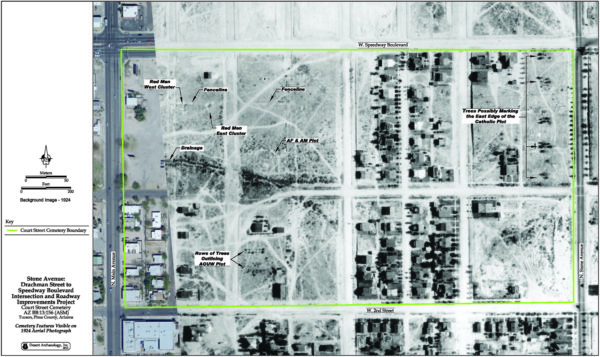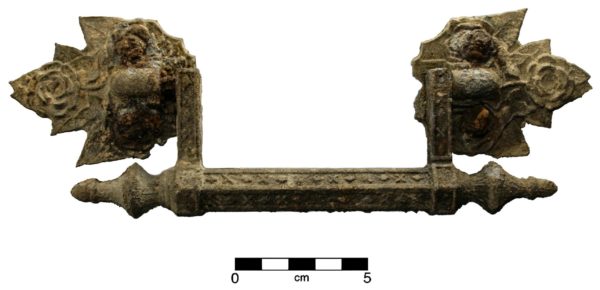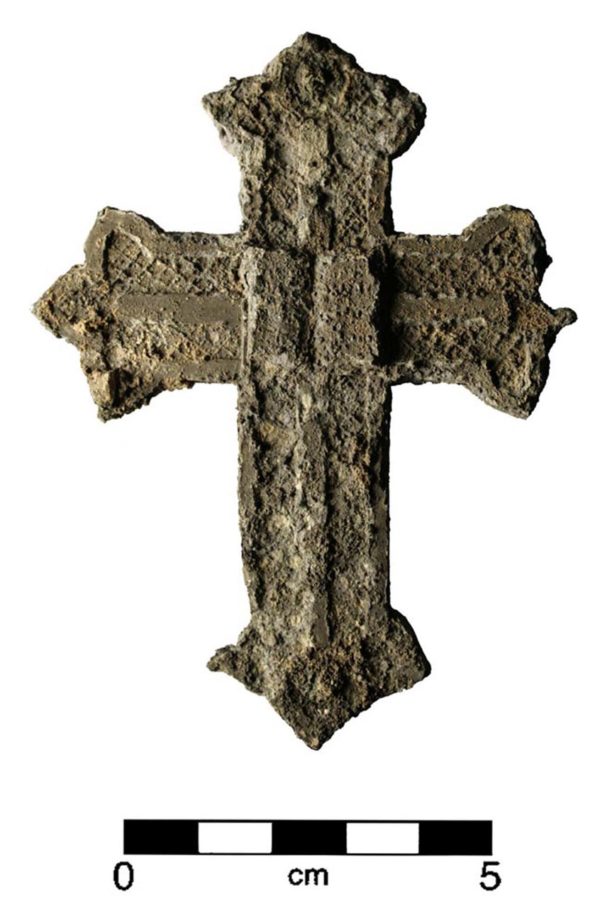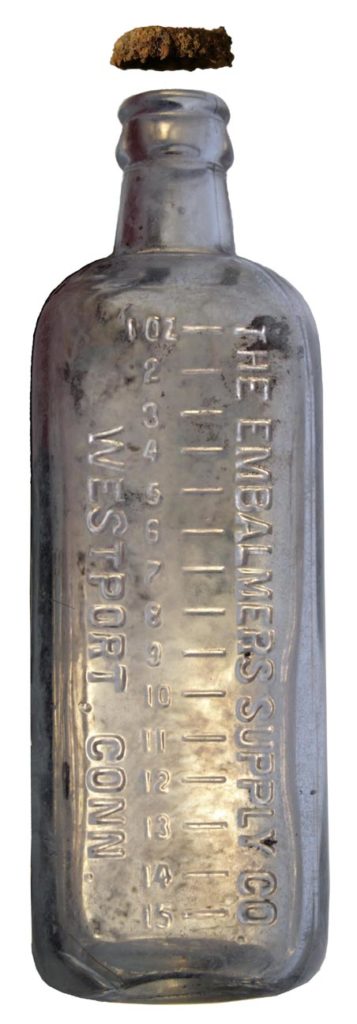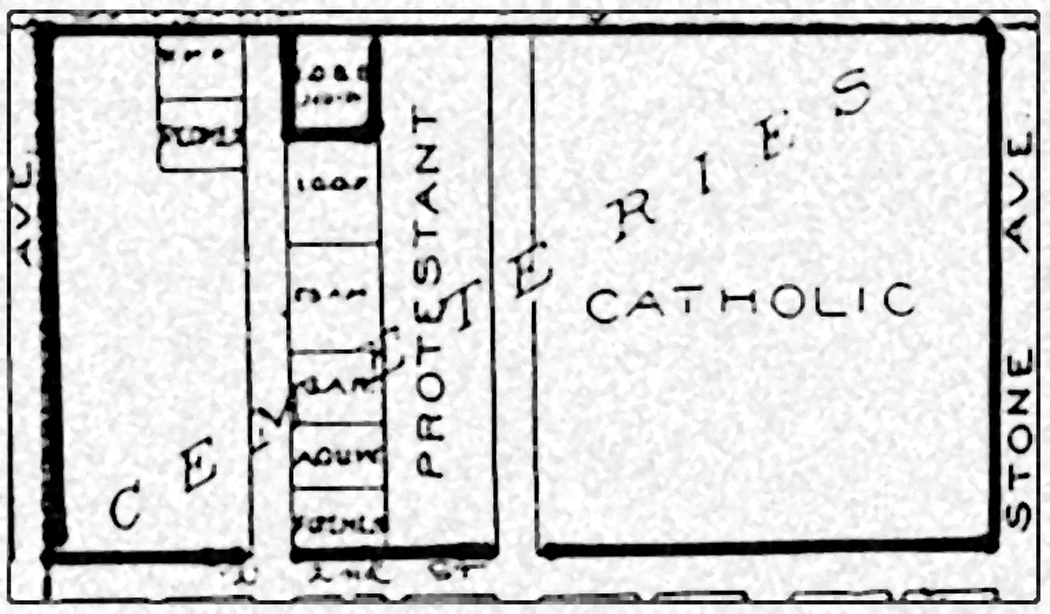
Historical Archaeology Halloween: The Burials under the Bank
Homer Thiel presents the story of two forgotten burials from the abandoned Court Street Cemetery north of downtown Tucson.
In 2012, Desert Archaeology was contracted by the City of Tucson to examine a parcel of land located at the southwest corner of N. Stone Avenue and W. Speedway Boulevard. At the time of the work, the parcel was a dirt lot. A decade earlier the corner was the location of a 1st National Bank of Arizona building, torn down in the early 2000s. Historically, the lot was within the boundaries of the Catholic portion of the historic Court Street Cemetery, in use from 1875 to 1909. Were there graves to be found?
The lot was fairly large, and stripping the entire surface would have been time consuming and expensive. Previously found burials in the cemetery were slightly more than six feet long and were mostly laid out east-to-west. The entire cemetery area is within the caliche zone, a hard, white calcium carbonate layer that develops in some places within the Sonoran Desert. Grave shafts dug through caliche are very visible due to the grave shaft cut and the mottled backfill within the shaft.
To see whether graves were present, Desert Archaeology hired Innovative Excavating to dig seven-foot-wide, north-to-south stripping trenches, interspaced with five-foot-wide backdirt piles. This would allow for the discovery of all adult-sized graves, if present.
Work began on the west side, closer to the center of the Catholic cemetery, but surprisingly, no graves were discovered. It wasn’t until a trench was dug close to N. Stone Avenue that a pair of graves, Features 36 and 37, were detected, in an area that was once beneath the floor of the demolished bank building. Despite the construction and demolition of the building, the graves were very well preserved.
Both graves were cut into the caliche layer and both contained rectangular coffins. Dr. Michael Diehl examined wood fragments using a microscope and found that both coffins were made from pine, probably imported into the area via the railroad.
Both coffins were nailed together with a variety of nails. Both had been covered in fabric. The cloth no longer survived, but iron tacks and diamond-shaped studs used to secure the fabric to the coffin wood were found.
The first coffin had four escutcheons and thumbscrews, used to screw the lid of the coffin down. Six swing bail handles decorated with roses were once attached to the outside of the coffin and were used by the pall bearers to carry the coffin to the grave. Coffin hardware analyst Jeremy Pye found matching hardware in late 19th and early 20th century catalogs.
Inside the first coffin, from burial Feature 36, was the skeleton of an adult male, aged about 40 to 45 years old at death. He had suffered from a number of health problems that had left distinctive evidence on his bones and teeth, which were analyzed by Dr. James Watson of the University of Arizona. These included dental caries, the loss of both lower first molars, vertebral pathologies that suggested the man had suffered back pain, evidence for a chest injury, and bony growths on his left foot. The man’s head and several left ribs were missing, either removed during an attempt at exhumation when the cemetery closed in the 1910s, or perhaps carried away by burrowing animals, such as dogs or coyotes. Clothing remnants (buttons, pants rivets, and cloth), indicate the man was buried wearing a shirt and trousers.
The coffin in the second burial, Feature 37, had five swing bail handles identical to those in Feature 36, indicating that the coffins were probably built by the same carpenter and perhaps suggesting the two burials were interred at the same time. Also recovered was a white metal cross decorated with a Bible in its center. Catholic burials in the Court Street Cemetery often have coffin hardware that incorporate Christian symbolism.
Much of the skeleton in the coffin had been exhumed. What was left included the left arm, the lower left leg, hand and foot bones, three teeth, 12 vertebrae, and the sternum. Dr. Watson was still able to determine that the bones came from a male aged 45 to 55 years old at death. He was buried wearing a shirt with a detachable celluloid collar, suspenders, pants, and probably shoes.
Scattered about in the interior of the coffin were 11 embalming fluid bottles, discarded by workers from a funeral home hired to exhume the burials. Each was embossed THE EMBALMERS SUPPLY CO. WESTPORT, CONN., along with graduated markings that allowed the embalmers to determine how much fluid to use.
Exhumed burials within the Court Street Cemetery almost always have human bones left behind. Why was this the case? The men hired to do the work had to dig down to locate the coffin, which was sometimes inside a wooden box. After breaking open the box, if present, and the coffin, they then had to remove human remains. The work was conducted mostly in the late spring and summer of 1915. It was hot, the monsoon season was starting, and the men were often six feet down inside a hastily dug hole with dirt threatening to collapse on them. Some of the burials were only a decade old and the remains may have been mummified or decomposing. It was almost certainly a horrible task and it is not surprising that complete remains were not collected.
A fired .32 caliber pistol bullet was also found in the second burial. This may indicate that the individual had suffered a gunshot wound that caused his death. Archival research has so far identified 27 men who died from gunshot wounds and who were buried in the Catholic portion of the cemetery. Five of these men match the age of the man in the coffin: Justo Carrillo (shot in face and neck in 1895), Eulalo Camacho (shot in abdomen in 1907), John Murphy (suicide 1908), Benito Olivas (accidental gunshot 1907), and Manuel Sotelo (gunshot 1903). It is also possible that the bullet was an accidentally dropped into the coffin during the exhumation process.
Our work cleared the lot for development and also provided more information the physical extent of the Catholic portion of the Court Street Cemetery. A 1924 aerial photo of the cemetery reveals a line of trees just west of our project area, and these trees probably mark the edge of the Catholic plot. The adjoining lot has been proposed for development in the past. It likely contains many more burials awaiting discovery.
Resources
Several of Desert Archaeology’s reports on our work within the Court Street Cemetery are available as free PDFs from the City of Tucson (scroll to the bottom of the page).


